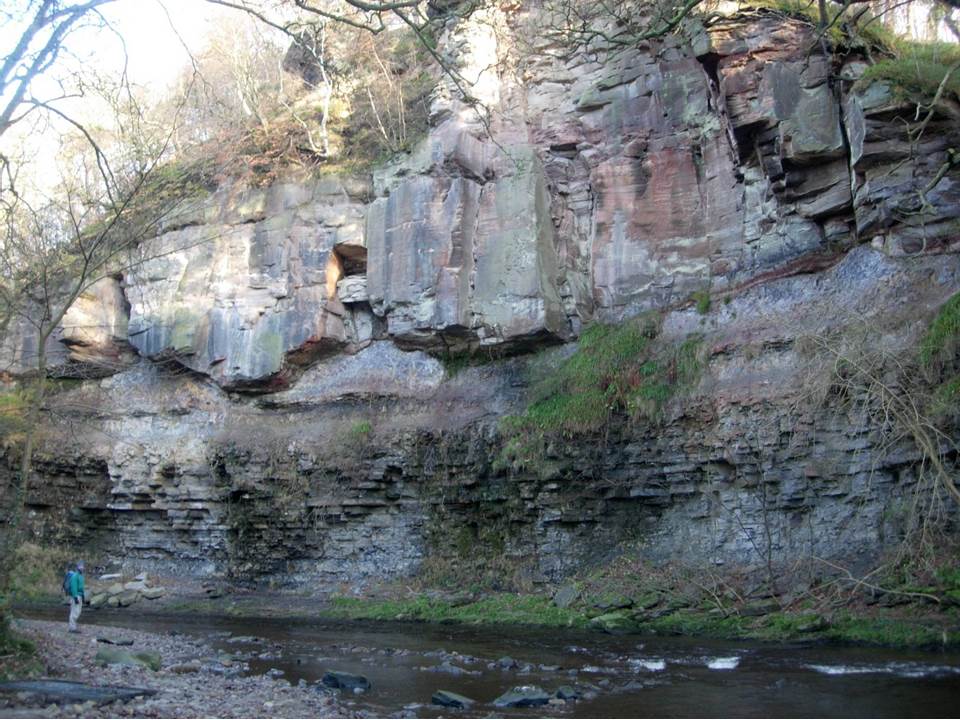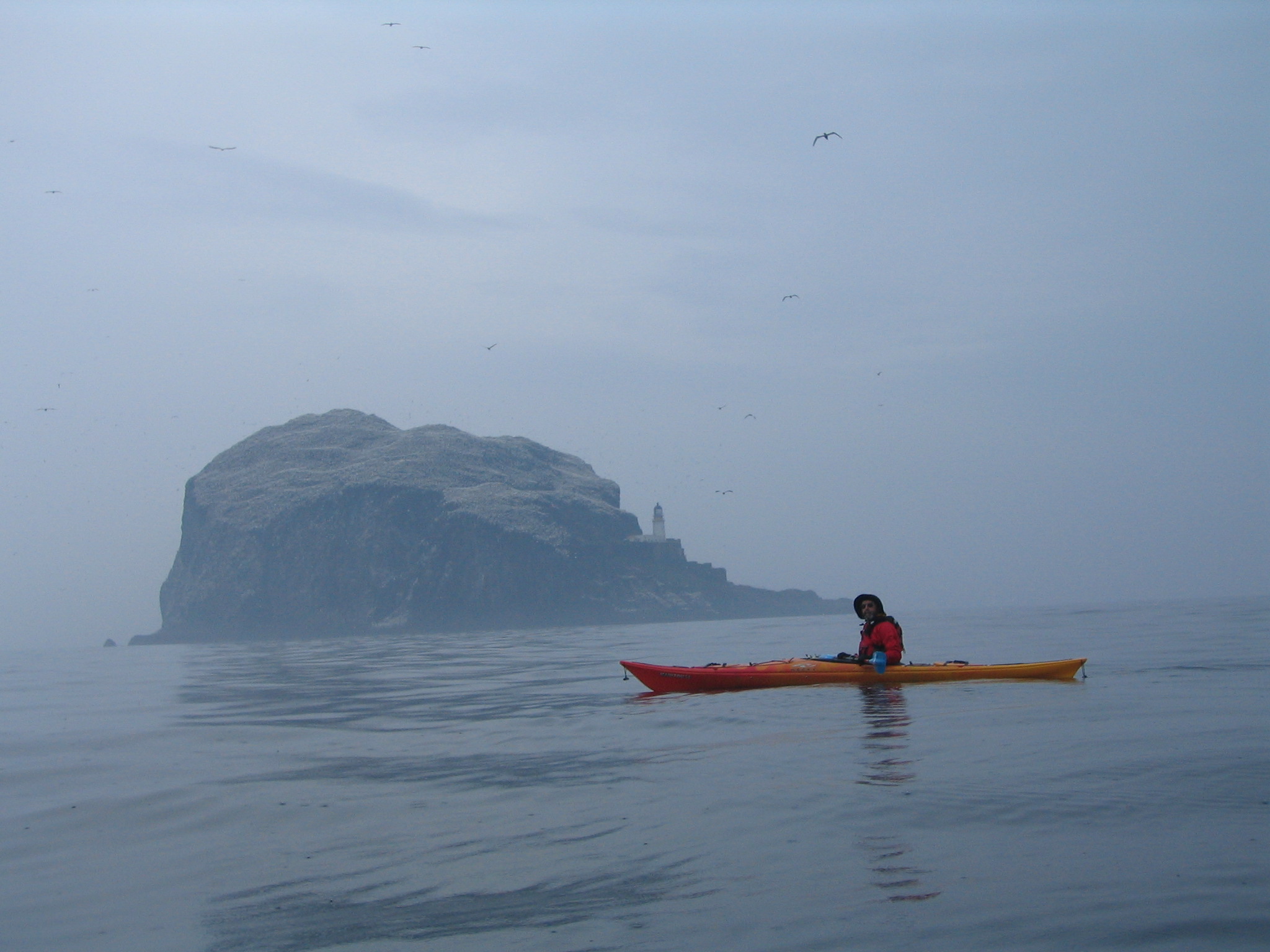Local Geology
There are great exposures of rocks around the Edinburgh area. Below are an entirely personal selection of some of the more interesting bits.

Rosslyn Glen (NT 266 621)
The photo above shows a fluvial (river) channel sandstone at the top of the cliff cuts down into overbank deposits below.
The base of the sandstone is irregular, indicating that the channel was eroded into the underlying, more bedded, sediments.
The lower part of the cliff has clear horizontal bedding, each layer represents a flood, when the river overflowed the channel and deposited mud and silt on the surrounding flood plane.
According to the online geological map provided by the British Geological Survey, the rocks here are part of the Upper Limestone Formation and are approximately 318 to 326 million years old, from the Carboniferous Period. Which just goes to show how inappropriate the names are for many of these Formations – there doesn’t appear to be any limestone at this particular location.
The photo is taken at the site of an old gunpowder works, which according to the information board there, exploded fairly regularly!
The gorge itself was formed as Scotland ‘rebounded’ after the last ice age (i.e. was uplifted as the weight of ice was removed around 10,000 years ago). The River Esk simply cut down as the land rose.

Hutton’s Unconformity, Siccar Point (NT 812 709)
One of the most famous sites in geology?
The photo shows above reddish sandstone, with more-or-less horizontal bedding lying on vertically bedded, older grey sediments – a relationship known as an unconformity.
The red sandstones are Devonian in age, and the grey sediments are Silurian, the age gap between the two is approximately 80 million years.
The Silurian sediments were folded and uplifted to form a mountain chain, which was the size of the present-day Himilayas. While they were being eroded, the red sandstones accumulated on top of the old mountains.
From this exposure, and 2 similar ones elsewhere in Scotland, Hutton realised that huge periods of time were required to explain the geological record – Hutton essentially invented what we call ‘deep time’ – the idea that the Earth is very old indeed (best estimate c. 4,500,000,000 years)
The Devonian red sandstones (there are breccias too, with angular boulders and pebbles set in sandstone, not visible in this photo) were deposited by flash floods and dry-land rivers, which flowed occasionally through the area, when it rained sufficiently.
The Silurian sediments are turbidites, alternating beds of muddy sandstones and mudstones, which were deposited on the floor of the ocean that once separated England from Scotland. The sediments were scraped off the ocean floor during subduction of the ocean, forming what is known as an accretionary prism.

Igneous and Glacial Features
The photo above shows Bass Rock, in the Firth of Forth, the estuary on which Edinburgh is sited.
The rock is a volcanic neck, made of phonolitic trachyte, apparently.
The shape is significant – clearly the igneous rock was more resistant to erosion than the surrounding sediments into which it was intruded (these are not visible now having been eroded away to below water level). However, the relatively gentle slope to the SSW (right in the photo) compared to the steeper cliffs on the other sides are presumably the result of glacial erosion – the rock is a roche moutonee, reflecting ice movement seawards (left in the photo) along the Forth of Forth.
The other islands in the Forth (Fidra, the Calf, Craigleith) all have the same shape – steep to the East, gentle slopes to the west, presumably for the same reason. The steep face is due to glacial plucking.
The prominent hill behind North Berwick (North Berwick Law; a good view point for Bass Rock if you don’t have a handy kayak!) is a well-known example of a crag-and-tail, i.e. a resistant hill with a down-stream ‘tail’ of glacial moraine deposited in the ‘shadow’ of the hill. It also indicates ice flow out to sea, i.e. from West to East.
At least 2 operators offer boat tours to the rock, which is worth a visit for the gannets which live there – Europe’s largest colony and the place the scientific name for gannets is derived from (Morus bassanus).
Arthur’s Seat, Edinburgh
The disused Camstones Quarry is found on the gently sloping back of Salisbury Crags, which are a prominent landmark in Edinburgh city centre.
Camstones were, apparently, a type of limestone used for polishing doorsteps. Oddly, there isn’t much demand these days. There doesn’t seem to be any of the limestone itself exposed presently, it is presumably covered by debris or grass.
The main face of rock (left of centre) are sandstones, dipping to the right (East). There are also some shales exposed but they are not well seen – look for a dark grey section directly below the highest part of the sky-line.
The sediments were laid down either by rivers, or perhaps by small deltas building into a lake. There are no fossils, which we would have expected to find if these were marine sediments (i.e. deposited in the sea).
The sandstones are not much different to those used to build many of the older buildings in Edinburgh – I’ve no idea if this particular quarry was used for building stone or not.


Comments are closed
Comments to this thread have been closed by the post author or by an administrator.